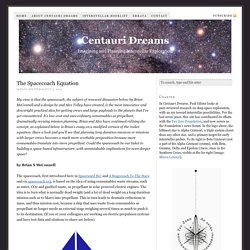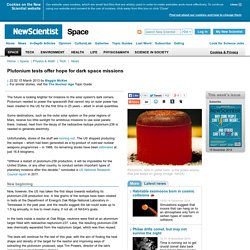

The Spacecoach Equation. My view is that the spacecoach, the subject of renewed discussion below by Brian McConnell and a design he and Alex Tolley have created, is the most innovative and downright practical idea for getting crews and large payloads to the planets that I’ve yet encountered.

It’s low-cost and uses ordinary consumables as propellant, dramatically revising mission planning. Brian and Alex have continued refining the concept, as explained below in Brian’s essay on a modified version of the rocket equation. Have a look and you’ll see that planning long duration missions or missions with larger crews becomes a much more workable proposition because more consumables translate into more propellant. Could the spacecoach be our ticket to building a space-based infrastructure, with unmistakable implications for even deeper space? By Brian S McConnell The spacecoach, first introduced here in Spaceward Ho! Image: The spacecoach. Planetary Society sur Twitter : "Sorry, we had to. #InternationalJokeDay #SpaceJoke...
Letha Hughes sur Twitter : "Northern Lights, Iceland Via @EarthPicturz #Earth #Science #Cosmos #Space . NASA's Dawn Mission sur Twitter : "Getting great #Ceres images from RC3; here’s another #space... Dawn RC3 Image 5. Steffen Christensen sur Twitter : "This SmartArt code in Excel can be encouraged to do some pretty cool things. #browndwarf #science #space #infographic. Watch Terry W. Virts's Vine "Physics is fun in zero gravity. Spinning chain #SpaceVine shows centripetal force causes circular shape."
Sam Cristoforetti sur Twitter : "Good night from #space. Buona notte dallo spazio. Observing Space sur Twitter : "Unusual Dusty Galaxy NGC 7049 #galaxy #space #hubble... 2009 April 8 - Unusual Dusty Galaxy NGC 7049. Dr. Ian O'Neill sur Twitter : ".@AstroSamantha has found a #SpaceInvader on the space station. What the heck is going on?? 'Space Invader' Found on International Space Station: Photos. Surface Area. What happens when you wring out a washcloth in space?
Tardigrade. Tardigrades (also known as waterbears or moss piglets)[2][3][4] are water-dwelling, segmented micro-animals, with eight legs.[2] They were first described by the German pastor Johann August Ephraim Goeze in 1773.

The name Tardigrada (meaning "slow stepper") was given three years later by the Italian biologist Lazzaro Spallanzani.[5] Since 1778, over 1,150 tardigrade species have been identified. Tardigrades are classified as extremophiles, organisms that can thrive in a physically or geochemically extreme condition that would be detrimental to most life on Earth.[6][7][3] For example, tardigrades can withstand temperatures from just above absolute zero to well above the boiling point of water, pressures about six times greater than those found in the deepest ocean trenches, ionizing radiation at doses hundreds of times higher than the lethal dose for a human, and the vacuum of outer space.
Tardigrades form the phylum Tardigrada, part of the superphylum Ecdysozoa. Description[edit] Apophis May Destroy Some of Earth's Satellites In 2029.
Space Radiation Environment. Climate models. Exoplanets. Fun and SF Space. Astrophysics: Fire in the hole! Andy Potts In March 2012, Joseph Polchinski began to contemplate suicide — at least in mathematical form.

A string theorist at the Kavli Institute for Theoretical Physics in Santa Barbara, California, Polchinski was pondering what would happen to an astronaut who dived into a black hole. Obviously, he would die. But how? According to the then-accepted account, he wouldn’t feel anything special at first, even when his fall took him through the black hole’s event horizon: the invisible boundary beyond which nothing can escape. But Polchinski’s calculations, carried out with two of his students — Ahmed Almheiri and James Sully — and fellow string theorist Donald Marolf at the University of California, Santa Barbara (UCSB), were telling a different story1. Free interview Zeeya Merali talks about what would happen if she fell into a black hole The team’s verdict, published in July 2012, shocked the physics community.
Fiery origins Quantum mechanics says that information cannot be destroyed. Selden's List of Resources for Celestia. Plutonium tests offer hope for dark space missions - space - 15 March 2013. The future is looking brighter for missions to the solar system's dark corners.

Plutonium needed to power the spacecraft that cannot rely on solar power has been created in the US for the first time in 25 years – albeit in small quantities. Some destinations, such as the outer solar system or the polar regions of Mars, receive too little sunlight for ambitious missions to use solar panels there. Instead, heat from the decay of the radioactive isotope plutonium-238 is needed to generate electricity. Unfortunately, stores of the stuff are running out. The US stopped producing the isotope – which had been generated as a by-product of cold-war nuclear weapons programmes – in 1988. "Without a restart of plutonium-238 production, it will be impossible for the United States, or any other country, to conduct certain important types of planetary missions after this decade," concluded a US National Research Council report in 2011.
Photography and imaging. Cmdr_Hadfield : Tonight's Finale: Our Earth... Astronomy Picture of the Day. Witter / AAVSO : #AAVSO SN2012am in M65: Here ... Stunning Photos of Solar Flares & Sun Storms. A year in space: 30 pictures of Earth taken from the International Space Station in 2011.